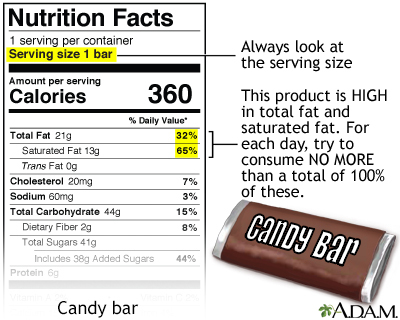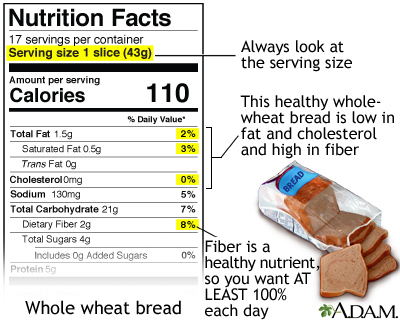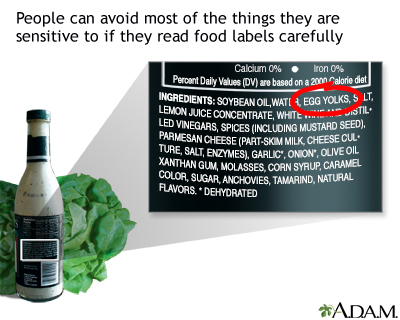Definition
Food labels contain a great deal of information on most packaged foods. Food labels are called "Nutrition Facts." The United States Food and Drug Administration (FDA) has updated the Nutrition Facts label, which most manufacturers will have in place in 2021.
Alternative Names
Nutrition labeling; Nutrition facts
Function
The United States government requires food labels on most packaged foods. The label offers complete, useful, and accurate nutrition information. The government encourages food manufacturers to improve the quality of their products to help people make healthier food choices. The consistent format of the label helps you directly compare the nutritional content of various foods.
SERVING SIZE
The serving size on the label is based on an average amount of food that people typically eat. Similar food products have similar serving sizes to make comparing products easier.
Keep in mind that the serving size on the label does not always equal a healthy serving size. It reflects the amount that people typically eat. It is not a recommendation for how much of that food to eat.
Most of the time, the serving size on a label does not match the serving size on the diabetic exchange list. For packages that contain more than one serving, sometimes the label will include information based on serving size and total package size.
AMOUNTS PER SERVING
The total number of calories per serving is indicated in large type. This helps consumers clearly see the number of calories per serving. The list of nutrients includes:
These nutrients are important to our health. Their amounts are shown in grams (g) or milligrams (mg) per serving to the right of the nutrient.
VITAMINS AND MINERALS
Vitamin D, calcium, iron, and potassium are the only micronutrients required to be on the food label. Food companies can voluntarily list other vitamins and minerals in the food.
PERCENT DAILY VALUE (% Daily Value)
Many nutrients include a percent daily value (%DV).
- This shows how much one serving contributes to the recommended total daily intake for each nutrient. Percent daily values make it easy for you to compare foods and see how a certain food fits into your diet.
- For example, a food that has 13 grams of fat with a %DV of 20% means that 13 grams of fat provides 20%, or one-fifth of your recommended total daily fat intake.
Percent daily values are based on a 2,000-calorie diet. You can use these numbers as a general guide, but bear in mind that your calorie needs may be higher or lower depending on your age, sex, height, weight, and physical activity level. Note that protein, trans fats, and total sugars do not have percent daily values listed.
NUTRIENT CONTENT CLAIMS
A nutrient content claim is a word or phrase on a food package that makes a comment about the level of a particular nutrient in the food. The claim will mean the same for every product. The following are some approved nutrient claims.
Calorie terms:
- Calorie-free: less than 5 calories per serving.
- Low-calorie: 40 calories or less per serving (serving size greater than 30 grams).
- Reduced-calorie: At least 25% fewer calories per serving when compared to the regular-calorie food.
- Light or Lite: One-third fewer total calories or 50% less fat per serving compared to the regular food. If more than half the calories are from fat, the fat content must be reduced by 50% or more.
Sugar terms:
- Sugar-free: Less than 1/2 gram of sugar per serving
- Reduced sugar: At least 25% less sugar per serving when compared to the non-reduced food
Fat terms:
- Fat-free or 100% fat-free: Less than 1/2 gram of fat per serving
- Low-fat: 1 g of fat or less per serving
- Reduced-fat: At least 25% less fat when compared to the regular-fat food
Cholesterol terms:
- Cholesterol free: Less than 2 milligrams of cholesterol per serving and 2 grams or less of saturated fat per serving
- Low cholesterol: 20 milligrams or less of cholesterol per serving and 2 grams or less of saturated fat per serving
- Reduced-cholesterol: At least 25% less cholesterol per serving compared to the regular food
Sodium terms:
- Sodium free: Less than 5 milligrams of sodium per serving
- Low-sodium: 140 mg or less of sodium per serving
- Very low sodium: 35 mg or less of sodium per serving
- Reduced sodium: At least 25% less sodium per serving than regular food
Other nutrient content claims:
- "High," "Rich In," or "Excellent Source Of": contains 20% or more of the daily value per serving
-
"Good source," "Contains," or "Provides": contains 10 to 19% of the daily value per serving
HEALTH CLAIMS
A health claim is a food label message that describes the relationship between a food or a food component (such as fat, calcium, or fiber) and a disease or health-related condition. The FDA is in charge of approving and regulating these claims.
The government has authorized health claims for these 7 diet and health relationships that are backed by extensive scientific evidence:
- Calcium, vitamin D, and osteoporosis
- Dietary fat and cancer
- Fiber in fruits, vegetables, and grain products and cancer
- Fiber in fruits, vegetables, and grain products and coronary heart disease
- Fruits and vegetables and cancer
- Saturated fat and cholesterol and coronary heart disease
- Sodium and high blood pressure (hypertension)
An example of a valid health claim you may see on a high-fiber cereal food label would be: "Many factors affect cancer risk; eating a diet low in fat and high in fiber may lower the risk of this disease."
For further information on specific health claims, refer to the information on diet and health.
INGREDIENTS
Food manufacturers are required to list ingredients in descending order by weight (from the most to the least). People with food sensitivities or allergies can obtain useful information from the ingredient list on the label.
The ingredient list will include, when appropriate:
- Caseinate as a milk derivative in foods that claim to be nondairy (such as coffee creamers)
- FDA-approved color additives
- Sources of protein hydrolysates
Most manufacturers offer a toll-free number to answer questions about specific food products and their ingredients.
FOODS EXEMPT FROM FOOD LABELING
Many foods are not required to have information on them. They are exempt from food labeling. These include:
- Airline foods
- Bulk food that is not resold
- Food service vendors (such as mall cookie vendors, sidewalk vendors, and vending machines)
- Hospital cafeterias
- Medical foods
- Flavor extracts
- Food colors
- Food produced by small businesses
- Other foods that contain no significant amounts of any nutrients
- Plain coffee and tea
- Ready-to-eat food prepared mostly on the site
- Restaurant foods
- Spices
Stores may voluntarily list nutrients for many raw foods. They may also display the nutrition information for the 20 most commonly eaten raw fruits, vegetables, and seafood. Nutrition labeling for single-ingredient raw products, such as ground beef and chicken breasts, is also voluntary.
References
Electronic Code of Federal Regulations website. Part 101 Food Labeling. www.ecfr.gov/cgi-bin/text-idx?SID=c1ecfe3d77951a4f6ab53eac751307df&mc=true&node=pt21.2.101&rgn=div5. Updated February 26, 2021. Accessed March 03, 2021.
Ramu A, Neild P. Diet and nutrition. In: Naish J, Syndercombe Court D, eds. Medical Sciences. 3rd ed. Philadelphia, PA: Elsevier; 2019:chap 16.
US Food and Drug Administration website. Food labeling & nutrition. www.fda.gov/food/food-labeling-nutrition. Updated January 4, 2021. Accessed February 18, 2021.
US Food and Drug Administration website. The new and improved nutrition facts label - key changes. www.fda.gov/media/99331/download. Updated January, 2018. Accessed February 18, 2021.




